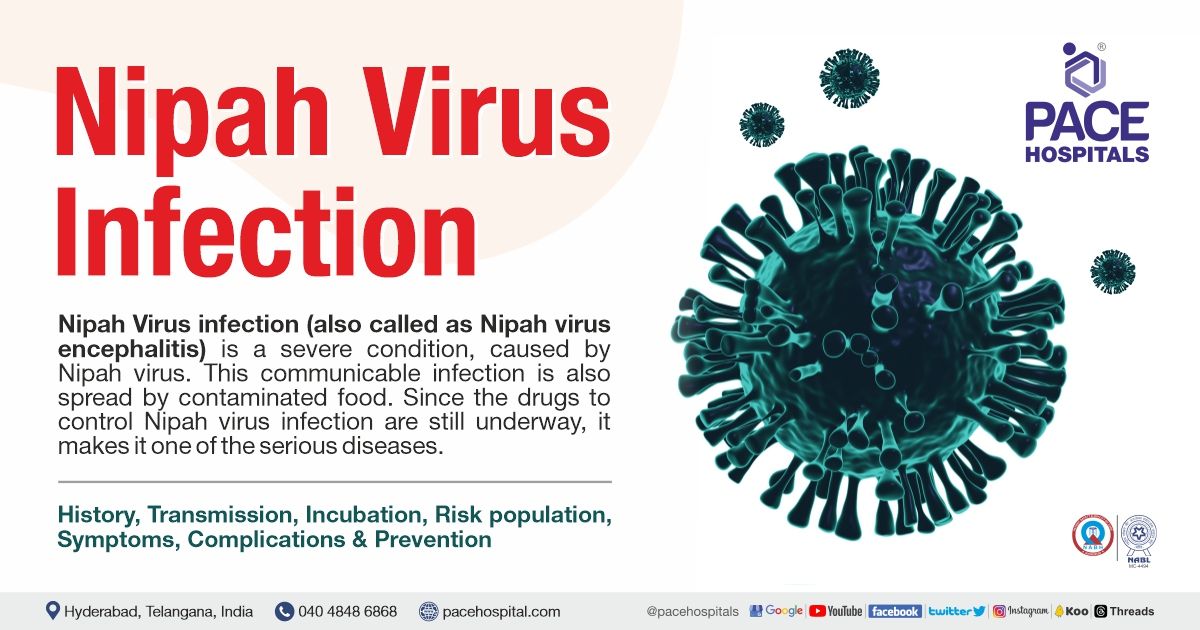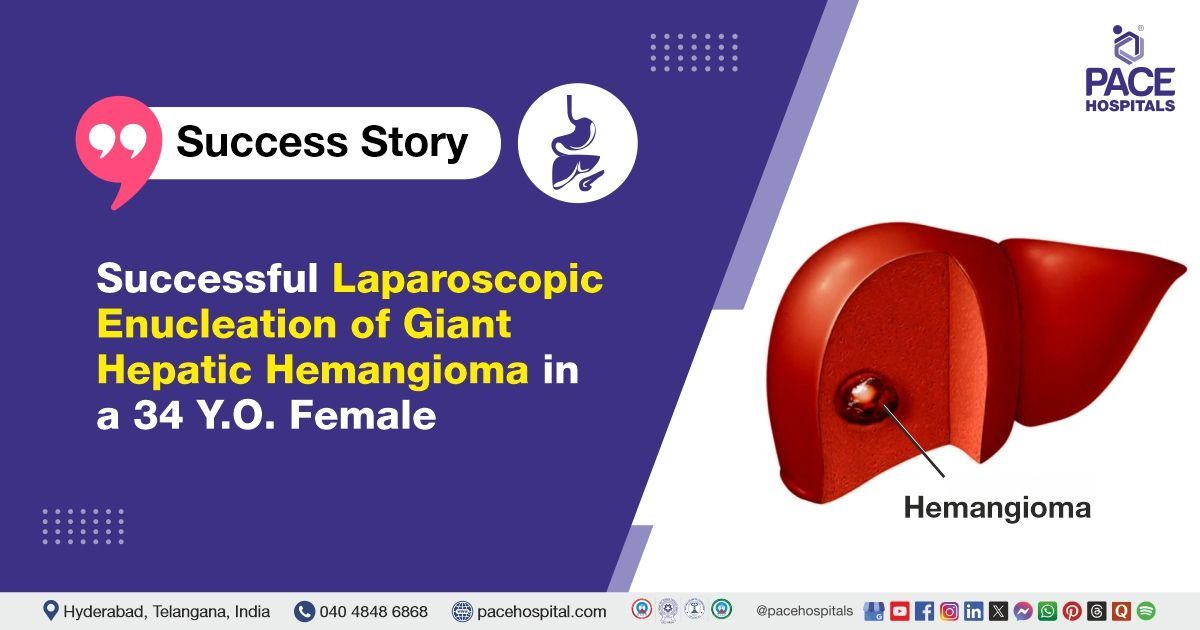Nipah Virus - History, Symptoms, Incubation, Complications, Prevention
Premise - Nipah virus news
In at least six confirmed cases of Nipah virus infections in the south Indian state of Kerala, two of whom have died. Owing to this Nipah virus outbreak in India which emerged in late August 2023, more than 700 people (Nipah virus victims), have been tested for infection - including health-care workers. This is the fourth Nipah outbreak to hit Kerala within a span of five years.
Death due to Nipah virus infection: The National Institute of Virology in Pune confirmed that the death by Nipah virus occurred in the two Nipah virus victims.
What is Nipah virus infection?
Definition of Nipah virus infection
The Nipah virus disease which caused due to Nipah virus (NiV) can be termed as Nipah virus infection (Nipah virus encephalitis). It is a zoonotic disease which meant that it can be spread from animals to humans, especially through bats and pigs.
Nipah virus name origin
Nipah virus (NiV) is a paramyxovirus belonging to the genus of Henipavirus, from Paramyxovirinae subfamily, Paramyxoviridae family, falling in the order of Mononegavirales . This Nipah virus infection was first described in 1999 and its name “Nipah”, is actually the Malaysian village name in which the person infected from the virus was first isolated succumbed to the disease.
Nipah virus structure
The Nipah virus has a α-helical cap structure tethering a viral polymerase to the nucleocapsid.
Size of Nipah virus: Combining various biophysical methods, such as NMR spectroscopy, x-ray crystallography, and small angle x-ray scattering, a 2020 study demonstrated that the Nipah virus could be imagined as a nanometre-sssize octopus-like protein. Similar to the octopus’s tentacles, the Nipah virus uses its long flexible arms to bind various sites of various cellular and viral partners to accomplish its virus replication, interfering with the interferon response and hijacking cellular machines.
Classification of Nipah virus
Considering its elevated pathogenicity along with the current absence of effective vaccines or treatments, the classification of Nipah virus pathogen falls under BSL-4 (biosafety level-4). The gene of Nipah virus produces non-structural proteins which indirectly reduces virulence through inhibiting the action of immune interferons.
Nipah virus origin (Nipah virus history)
The Nipah virus disease is a newly emerging infection that can be transmitted from its natural host, the fruit bat, to animals and humans alike. First identified and isolated in 1998 from a Malaysian village “Sungai Nipah”, the Nipah infection is a viral disease with a high pathogenicity. The outbreak there spread among the cattle especially the pigs which proceeded to infect approximately 300 people of which more than 100 people met their demise within a year. During the origin of Nipah virus, it is termed as a neurologic and respiratory disease which emerged from porcine spread.
Nipah virus across world
Since the 1990s, the outbreak of Nipah virus has been seen sporadically, mostly in the South-Eastern Asia. An epidemiologic review published in 2019 demonstrated that there have been a total 639 Nipah virus victims had been reported from Malaysia (265 cases), Bangladesh (261 cases), India (85 cases), Philippines (17 cases), Singapore (11 cases) with about greater mortality rate.
There have been various pieces of evidence which shows that presence of the virus in various regions across the globe without any clinical disease. The presence of the virus has also been found in fruit bats in Cambodia, Madagascar, and Thailand. It has been evidenced that several species of domestic animals including dogs, cats, goats, sheep, and horses are also prone to the viral attack.
Nipah virus India - timeline
The timeline of the Nipah virus outbreak in India had been created from various sources.
- Year 2001 – the first outbreak of Nipah virus in India is seen in Siliguri, West Bengal, which was located closely to Bangladesh, a country suffering with Nipah virus outbreak.
- Year 2007 – this outbreak of Nipah virus in India is seen in Nadia, West Bengal.
- Year 2018 - this Nipah virus outbreak was seen in Kozhikode and Malappuram, Kerala, the index patient was reported to have contracted the infection through fruit-eating bats.
- Year 2023 - in Kozhikode, Kerala, the Nipah virus outbreak occurred due to infection through fruit-eating bats.
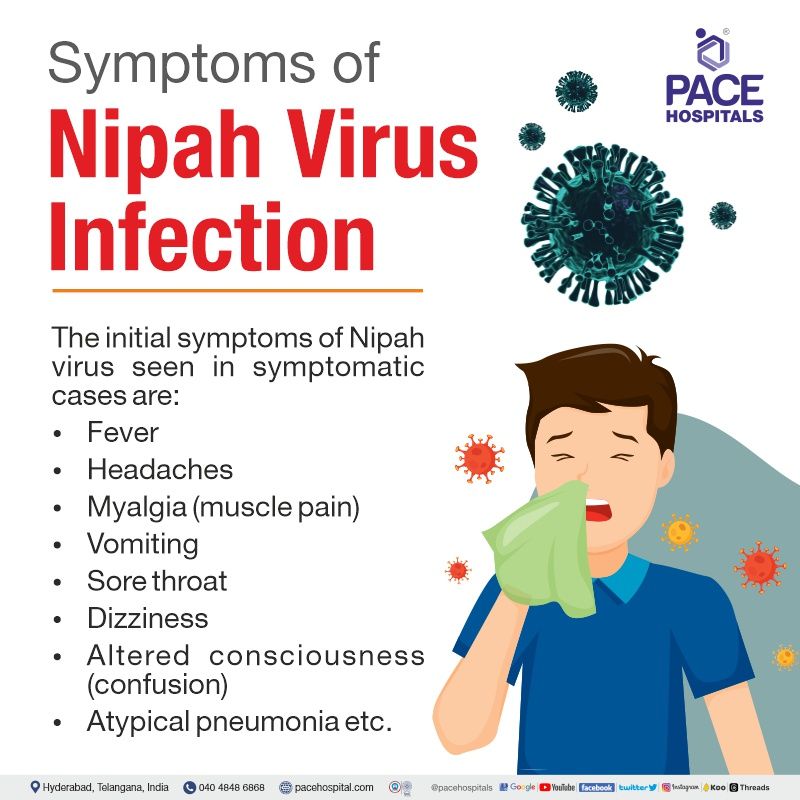
Nipah virus symptoms
The Nipah virus infection symptoms in humans could range from being asymptomatic to the symptoms of episodes of acute respiratory infection, and the symptoms of fatal encephalitis. The initial symptoms of Nipah virus seen in symptomatic cases are:
- Fever
- Headaches
- Myalgia (muscle pain)
- Vomiting
- Sore throat
- Dizziness
- Altered consciousness (confusion)
- Atypical pneumonia
- Severe respiratory problems
- Acute respiratory distress
In severe cases, encephalitis (inflamed brain tissues) and seizures may occur which need prompt clinical attention as the patient could progress to coma within 24–48 hours.
Although 40-75% of the patients meet their demise, there are cases of long-term survivors associated with personality changes and persistent convulsions.
Nipah virus transmission
Despite being a zoonotic disease (transmitted from animals to humans), the Nipah virus disease spreads through contaminated food and even through infected patients directly.
Risk factors and etiology of Nipah virus include:
- Proximity (touching, feeding or attending the infected person), thus aiding Nipah virus infection through droplets.
- Consumption of fresh date palm sap is the most common route; the fermented date palm juice is a delicacy which permits viral transmission.
- Infrared cameras showed that bats (Pteropus giganteus) often visit date palm trees during sap collection and lick them. Bats are the natural reservoir of Nipah viruses.
- Since the sap is a sugar-rich solutions (fruit pulp), the virus can survive for days.
- Bats eat fruits and the fruit spillage is consumed by other animals (usually pigs) infecting them.
- Pork meat infected with Nipah virus could be exported and its consumption can infect humans.
- Finally, the combination of fruiting trees surroundings, sugary fruits such as date palm, bats, pigs and human altogether form the origin and spread of Nipah virus infections.
- Close contact with affected humans can lead to spread of Nipah virus to other persons, usually through aerosol droplets.
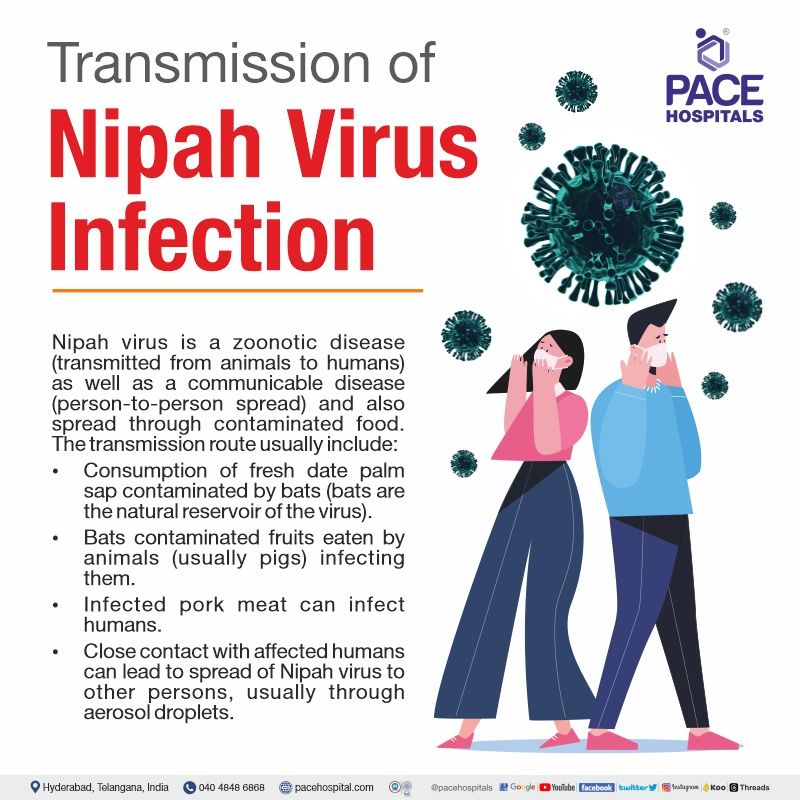
Incubation period of Nipah virus
It could take about 4–14 days to express the symptoms from the date of infection (incubation period). Nevertheless, there are reports of at least 45 days of incubation period. Nipah virus is reported to spread even during the incubation period, which is why it is moving during the incubation period is not recommendable.
Risk population of Nipah virus infection
A 2018 Chinese study outlines the common risk population who are prone for Nipah virus. They include:
- Fruit farmers: Since bats at the fruit, the virus could transfer to the farmers who grow them. Similar risk could be seen among fruit traders.
- Palm wine brewers: In the preparation of palm wine, the sap from the tree of date palm is collected in earthen pots. There are heavy chances of its contamination through the urine or saliva of fruit bats.
- Cattle herders: People dealing with livestock and cattle, especially pigs are at a greater risk of contracting the disease.
- Tourists:
The tourists who may venture into the rustic villages to experience the nativity could be at risk of contracting may Nipah virus from either fruit farmers, fruit traders, palm wine brewers, cattle herders or through direct contact of infected person.
Complications of Nipah virus infection
The mortality rate of Nipah virus is quite high, which varies with region and demographic profile of the patient. The survivors may experience persistent symptoms such as
- Disabling fatigue - long periods of fatigue which can cause absences to work.
- Severe acute encephalitis - inflammation of brain tissues
- Respiratory complications - such as breathlessness
- Long-term neurological sequelae such as facial paralysis, weakness etc.
- Behavioural abnormalities
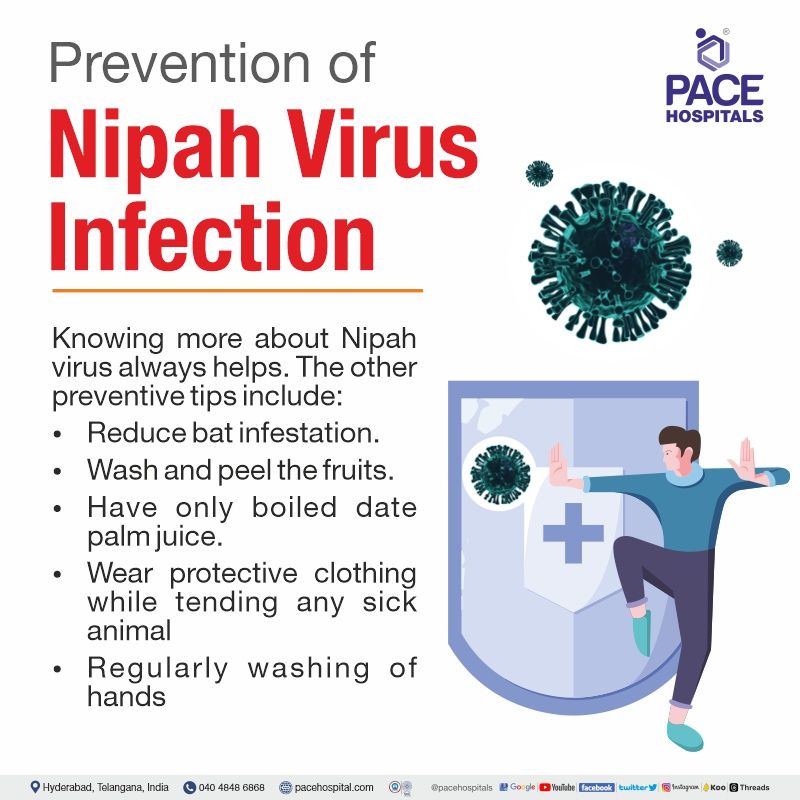
Prevention of Nipah virus infection - Precautions for Nipah virus
Since the Nipah virus vaccine is under trials, extreme measures are to be ensured to avoid any outbreaks. The preventive measures of Nipah virus are to be continued both for livestock and for humans.
Controlling Nipah virus in pigs - Precautions for Nipah virus in livestock
- Thorough disinfection with appropriate detergents followed by cleaning of the pig sty could be an effective tip in preventing infection.
- In case of an outbreak, the stables and stys must be quarantined immediately.
- Either incineration or burial of the animal carcasses must be completed once the culling is finished, thus reducing its risk of transmission to people.
- Restricting the animal movement to other areas can reduce the disease spread to other animals.
Reducing the risk of infection in people - Precautions for Nipah virus among humans
- Increasing the awareness of the Nipah virus, along with education of risk factors can help in understanding Nipah virus preventive measures.
- Reduction of bat infestation among the areas of fresh food and date palm sap.
- Before consumption, the fruits must be washed thoroughly and peeled.
- Only boiled date palm juice must be consumed.
- While tending the sick animal, protective clothing and gloves must be worn.
- With regular washing of hands, Nipah virus prevention can be avoided after caring for or visiting sick people.
Nipah virus diagnosis
Since the Nipah virus infection is a recent phenomenon, the specificity of its initial signs and symptoms are questionable. With the rarity of the disease occurrences, the diagnosis of Nipah virus infection cannot be divulged at the time of presentation. The common lab diagnosis of Nipah virus include:
- Real time polymerase chain reaction (RT-PCR)
- Antibody detection via enzyme-linked immunosorbent assay (ELISA)
- Polymerase chain reaction (PCR) assay
- Virus isolation by cell culture.
Nipah virus treatment
The Nipah virus treatment medicine, vaccines or drugs specific for Nipah virus infection are still underway. Currently, Intensive symptomatic care is the only viable option in treating severe respiratory and neurologic complications.
Share on
Request an appointment
Fill in the appointment form or call us instantly to book a confirmed appointment with our super specialist at 04048486868

